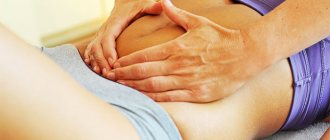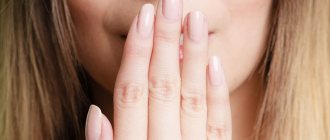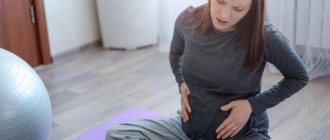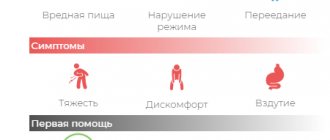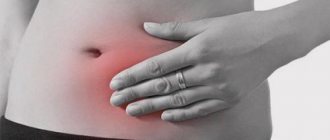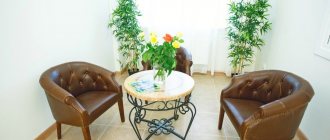Can your stomach hurt from constipation?
Constipation (colostasis) is characterized by difficulty defecating, low stool frequency, and insufficient bowel movements. Signs of constipation also include the absence of bowel movements for two days or more, and hard, dry stools. Other signs may also be observed - symptoms of general intoxication, increased sweating, general poor health, headaches. Problems with defecation are often accompanied by pain in the abdomen, rectum and stomach. All this causes physical discomfort and may indicate the presence of serious diseases.
Acute and chronic anal itching
There are acute and chronic primary anal itching, and the form of the disease is also its stage. Anal itching in acute form begins suddenly, has a constant course and strength, the skin in the areas of itching becomes moisturized, traces of scratching and an increase in perianal folds are observed. Chronic itching, on the contrary, is characterized by a slow onset, the skin of the perianal area is dry, thin, has altered pigmentation, scratch marks are absent or look like thin linear abrasions, skin folds are poorly defined.
Why does constipation hurt?
As a result of impaired mobility, feces accumulate inside the intestines, which gradually provokes intoxication. Accumulated feces put pressure on the intestinal walls, causing pain. In addition, with constipation, gas formation increases and the passage of gases is disrupted. This also causes pain and discomfort. In some cases, pain can be felt not only in the lower abdomen, but also on the right, left, as well as in the right hypochondrium and lower back.
Researchers note that the acute pain of constipation is more likely to result from cramping. Thus, Shulpekova draws attention to the fact that stool retention is accompanied by “spastic pain.” (Shulpekova Yu. O., 2007, p. 1165). Indeed, spasms of smooth muscles that occur in response to a mechanical stimulus in the form of dense feces and accumulated gases are felt by us as sharp, cramping pains. The localization of pain can be completely different. It all depends on the specific part of the intestine that is currently affected, as well as upon exposure to other factors previously.
Primary and secondary anal itching
Anal itching can be primary or secondary. Secondary anal itching is a symptom of diseases such as anal fissure, hemorrhoids, helminthic infestations, anal sphincter insufficiency, proctosigmoiditis, intestinal disorders (constipation, diarrhea), genital inflammation, skin fungus in the sacrococcygeal region, exposure to allergens. Anal itching may indicate hidden diabetes. The causes of primary anal itching, which experts also call true, are not fully known.
Causes of pain due to constipation
Defecation disorders occur for various reasons:
- Poor nutrition and sedentary lifestyle. Due to an unbalanced diet and insufficient physical activity, motor skills are impaired and an imbalance of microflora occurs. The result is constipation.
- Developmental anomalies of the large intestine - long colon and/or sigmoid colon.
- Diverticular disease of the colon.
- Diseases of the colon, rectum and anus. As a result of these diseases, physiological obstacles appear that impede the movement of feces.
- Diseases of the nervous system, endocrine and gynecological pathologies inhibit metabolic processes in the body.
- Irritable bowel syndrome is discomfort during bowel movements, accompanied by a change in the consistency and/or frequency of stool.
- Taking certain medications.
Constipation often occurs while taking antidepressants, antibiotics and other medications. Also, problems with bowel movements often occur during pregnancy, after childbirth and in the postoperative period.
Signs of intestinal stasis that indicate serious pathologies include blood in the stool, severe bloating (tympanitis), weight loss, and vomiting.
Therefore, as we see, the causes of pain during constipation may be hidden in the causes of defecation disorders themselves. In the absence of organic or other pathologies, discomfort may be associated with tissue compression, stretching of the intestinal walls and their resistance to pressure, and irritation of receptors. Sometimes pain is accompanied by false urges to defecate and urges that did not bring the desired result. In most cases, painful sensations can occur both in the interval between urges and in their absence.
Possible complications of constipation
Frequent constipation may be accompanied by heaviness in the abdomen and pain before, during or after bowel movements. Such problems can lead to unpleasant consequences. Most common complications:+
- poisoning of the body;
- exacerbation of hemorrhoids;
- rectal fissures;
- risk of cancer.
General intoxication due to stagnant feces can cause deterioration in health and decreased performance. Disruption of the intestinal microbial balance during chronic constipation leads to exacerbation of allergic diseases, skin rashes, and a decrease in the body's resistance to infections.
It is known that the risk of developing colorectal cancer is higher in people with chronic constipation. Delayed bowel movements lead to disruption of cholesterol metabolism and the development of atherosclerosis, and consequently, cardiovascular diseases.
Diseases of the anorectal area often accompany constipation. This is due to the fact that dense feces injure the mucous membranes of the rectum, which causes the appearance of anal fissures. And an increase in intra-abdominal pressure can lead to the formation of hemorrhoids.
Prices for services
Initial appointment with a proctologist (assessment of patient complaints, medical history, external examination of the anus, digital examination of the rectum, anoscopy if indicated)
Primary appointment – visiting a doctor of a specific specialty for the first time. Make an appointment
1510 ₽ 2160 ₽
Repeated appointment with the proctologist
Make an appointment
700 ₽
Severe itching and burning in the anus are characteristic of the following diseases and conditions:
- internal and external hemorrhoids, proctitis, paraproctitis;
- genital warts in the perianal region and rectal mucosa;
- acute and chronic anal fissure;
- fistula tracts in the anus;
- failure of the anal sphincter and involuntary contact of rectal contents with the skin of the perianal area;
- perianal dermatitis;
- inflammatory bowel diseases (ulcerative colitis, Crohn's disease, etc.);
- dermatological diseases (psoriasis, eczema);
How pain manifests itself
Constipation pain occurs due to the accumulation of stool in the large intestine. Dense feces stretch the intestinal walls, resulting in compression and disruption of the functioning of other internal organs.
The discomfort associated with constipation varies. Pain can occur in the abdomen, sphincter area, lower back, and groin area. Pain during defecation often occurs due to the appearance of cracks in the anal area, the development of hemorrhoids, and inflammation of the rectum. Pain often appears during the urge to defecate, as well as between them.
Sometimes the pain of constipation in adults suddenly occurs directly during bowel movements. This is associated with diseases of the gastrointestinal tract: pancreatitis, appendicitis, cholecystitis. Only a doctor can determine the true cause of constipation and pain. If defecation problems are persistent, it is best to undergo a full medical examination.
Nature of pain
With constipation, pain varies in severity and location. If the lower abdomen hurts, then most likely constipation is caused by errors in diet and insufficient water consumption. As a rule, the pain is dull, stabbing, accompanied by colic and rumbling. In this case, the discomfort goes away immediately after defecation.
Acute and aching pain during constipation, which does not go away after a bowel movement, may indicate gastrointestinal pathologies. The location of the pain depends on the cause of its occurrence. For example, with acute gastritis, the epigastric region hurts, heartburn and nausea are observed. Intestinal obstruction is characterized by pain in the left side, as well as fever. Chronic pancreatitis is accompanied by girdling or severe pain in the left or right hypochondrium.
Pain syndrome is often accompanied by loss of appetite, headache, heartburn, and bad breath. In addition, with constipation, there is often a feeling of fullness, a feeling of a plug in the rectum. Hard stool damages the walls of the rectum and sphincter, hence causing pain that can persist for a long time after defecation.
Inflammation of the appendages and other gynecological problems can also cause constipation. Intestinal problems often arise against the background of kidney disease. In this case, the pain will be localized in the lumbar region, as well as in the lower abdomen.
Cramping pain that occurs as a result of spasms of the smooth muscles of the intestine appears due to the accumulation of gases and intestinal colic. This significantly complicates the process of defecation. With intestinal colic, the pain is pronounced and increasing in nature. With colic, tension in the muscles of the anterior abdominal wall, bloating and cramps are observed. This condition can last from several hours to several days. Persistent constipation or diarrhea usually occurs after colic.
Symptoms such as flatulence, bloating and constipation are often associated with irritable bowel syndrome. IBS is characterized by pain and bloating, which are accompanied by changes in stool consistency.
The severity of unpleasant symptoms depends on the cause of constipation. This condition cannot be left to chance. The first thing you need to do when unpleasant symptoms appear is to visit a therapist or gastroenterologist. The doctor will conduct the necessary diagnostics, prescribe tests and examinations to identify factors that provoke problems with bowel movements.
Practical recommendations for the treatment of constipation
Constipation is the third most common symptom in palliative care after pain and anorexia. We invite specialists to familiarize themselves with the leaflet on the treatment of constipation in palliative patients, prepared by the Vera Foundation. You can download the memo in pdf format at the end of the article.
Definition
Constipation is an irregular and difficult passage of solid stool through the intestines or a rare passage of small amounts of hard stool (less than 3 times a week), a feeling of incomplete bowel movements or passage of stool less frequently than was normal for the patient before the illness.
The presence of constipation is determined by the patient himself. Passing stool does not have to be daily. If the stool is soft and passes without difficulty once every 2-3 days, this can be considered normal. Constipation is the third most common symptom in palliative care after pain and anorexia. The incidence of constipation in cancer patients ranges from 32% to 87%, in the case of taking opioids - 90%.
The goal of all measures is to prevent constipation, and if it occurs, proper treatment.
Causes of constipation
Organic factors
● Opioids:
- increase the tone of the sphincters (ileocecal valve, anal sphincter);
- enhance segmentation (pyloric, small and large intestines);
- increase the absorption of water and electrolytes in the small and large intestines, which leads to drying and hardening of the stool;
- weaken the defecation reflex (the rectum becomes less sensitive to stretching).
In the case of a high likelihood of severe constipation (relevant medical history), it is preferable to choose opioids with less effect on the intestines (for example, Targin).
● Other medications : antacids, antiemetics (5-HT3 antagonists), diuretics, iron and calcium supplements.
● Metabolic disorders : dehydration (fever, vomiting, polyuria, insufficient drinking), hypercalcemia, hypokalemia, uremia, hypothyroidism, diabetes.
● Neurological disorders : brain tumors, lesions at the level of the spinal tract, infiltration of the sacral nerves, autonomic disorders (primary, such as Parkinson's disease, multiple sclerosis, motor neuron disease, or secondary, associated with cancer).
● Structural disorders : tumor masses in the pelvis, post-radiation fibrosis, hemorrhoids, anal fissures, perianal abscess.
Functional factors
- Diet : poor appetite and small amount of food taken, insufficient amount of fluid taken, low amount of fiber in food.
- Environmental conditions : lack of personal space, uncomfortable conditions for passing stool.
- Other factors : advanced age, low activity, weakness, limited mobility, bed rest, depression.
Consequences of constipation
- Anorexia, nausea, vomiting, obstruction of the large intestine.
- Bloating, discomfort, pain.
- Pain in the rectum (constant or spastic).
- Dysfunction of the urinary system (difficulty urinating, urinary retention, urinary incontinence due to bladder overflow).
- Discharge from the rectum, stool leakage, overflow diarrhea.
- Delirium.
Assessment/History
When collecting an anamnesis, since the conversation touches on a very intimate area, it is necessary to first predispose the patient to the conversation. You should pay attention to the factors presented in Table 1.
Clinical examination
Abdominal examination:
- increase;
- tension in the abdominal wall, especially in the area of the cecum (right lower quadrant);
- palpable fecal masses, which must be distinguished from a tumor: fecal masses most often accumulate in the descending colon (left lower quadrant), are usually mobile and displaceable when pressed, disappear after constipation is eliminated.
Digital examination of the rectum:
- stool hardness and consistency;
- empty, dilated rectum (may be a sign of more proximal hard stool);
- hemorrhoids, painful fissures, fistulas in the anal sphincter area;
- intracavitary tumor or external compression of the rectum by a mass in the abdominal cavity;
- scars or stenosis in the anal area.
Additional examination methods (in case of fairly stable condition and long-term prognosis) :
- in acute conditions: a simple x-ray of the abdomen (if there are signs of intestinal obstruction or accumulation of a large amount of feces in the large intestine).
Prevention
- Fluid intake: 1500–2000 ml per day, in small portions throughout the day.
- Intake of dietary fiber (bran 20–25 g per day), if the patient drinks at least 1500 ml of liquid per day. Whole fruits and vegetables are better than juices; cereal porridge, whole grain bread.
- Physical exercises for the patient in accordance with his abilities, condition, preferences (frequency, intensity and duration), so that they are feasible and carried out.
- If physical capabilities are reduced: twist the body, raise bent legs alternately for 15–20 minutes a day.
Personal space
- It is advisable to defecate in the toilet room or use a bedside toilet (instead of a bedpan).
- Try to have a bowel movement within 30–60 minutes of eating to take advantage of the gastrocolitic reflex.
- Take the correct position during defecation, which increases pressure in the abdominal cavity: place your feet on a stool so that your knees are higher than your hips, and lean forward, keeping your back straight, with your elbows resting on your knees.
- Raise the height of the toilet seat or install grab bars to help the patient be more independent.
For bedridden patients, raising the head of the bed, lying on the left side with your knees pressed to your stomach can make it easier to pass stool.
In the last days of life, one must weigh the need and the burden on the patient when trying to obtain regular bowel movements. The decision is made individually; bowel emptying may lose priority compared to relieving other symptoms.
Drug treatment of constipation
Recommended measures for the treatment of constipation for various clinical manifestations of this condition are presented in Table 2, characteristics and features of the use of drugs for the treatment of constipation - in Table 3.
Many oral laxatives, rectal suppositories and enemas have the same side effects - cramping, colic, flatulence, nausea and diarrhea - which can be reduced by titrating the dose.
Treatment tactics for constipation (see Appendix 1)
While taking opioids:
- Begin laxative therapy at the start of opioid treatment (in the absence of diarrhea). Laxatives with osmotic action that increase the adsorption of water in the intestine (lactulose, macrogol, etc.), as well as agents that stimulate the function of the colon (senna, bisacodyl, sodium picosulfate) or small intestine (castor oil, vaseline oil) will help to facilitate bowel movements.
For constipation without opioid use:
- Start with a gut stimulant (eg, senna) and an osmotic laxative (eg, lactulose). Remember that when taking laxatives, stool may only appear on the third day.
- If the stool is soft but not frequent enough, increase the dose of the stimulant (senna, bisacodyl).
- If the stool is hard, increase the dose of an osmotic laxative (lactulose for a mild effect, magnesium sulfate for a stronger effect).
- If there is no bowel movement for three days, perform a digital examination of the rectum and, if there are no contraindications, prescribe a rectal suppository or microenema.
For constipation accompanied by signs of intestinal obstruction:
- If stool is in the rectum, use a glycerin suppository to soften the stool; after an hour, try digital removal of feces (after prescribing an analgesic and a sedative).
- If the fecal impaction is higher, in the descending colon, use an oil microenema.
For colostomy:
- If the colostomy is proximal, then the effect of laxatives may not be effective, and suppositories are not effective, since they cannot stay inside the colostomy.
- If the stoma is in the descending or sigmoid bowel, an enema may be effective.
For paraplegia:
- Oral laxatives may be effective in moving stool toward the rectum.
- Empty your rectum using one of the following methods: suppositories, enema, or digital stool removal.
O.V. Artykova for her assistance in preparing the materials. (Head of the Hospice “Zelenograd” branch of the State Budgetary Healthcare Institution of the Central Clinical Hospital of the Doctor of Health), A. V. Kryukov (clinical pharmacologist of the State Budgetary Healthcare Institution of the Central Clinical Hospital of the Doctor of Health).
List of sources
1. Chronic pain syndrome (CPS) in adult patients in need of palliative care, 2016, ICD 10: R52.1/ R52.2.
2. Introducing Palliative Care Fifth Edition. Editors Twycross R., Wilcock A., 2016.
3. Hospice and Palliative Care Training for Physicians. Unipac Self-Study Program, 2008.
4. Lanarkshire Palliative Care Guidelines, 2012.
5. ProCare HospiceCare. Hospice Medication Utilization Guidelines. Eds. S. Shah, M. Madison. www.ProCareHospiceCare.com.
6. Larkin PJ The management of constipation in palliative care: clinical practice recommendations. Palliative Medicine, 2008; 22: 796–807.
7. Constipation Symptoms in Adults with Cancer. Cancer Care. Ontario, 2012.
You can download the “Constipation in Palliative Care” leaflet in pdf format here:
Treatment of pain due to constipation
In the fight against pain due to constipation, the following will help:
- Nutrition aimed at increasing the amount of fiber consumed. Diet is the main method of treating functional constipation caused by decreased intestinal motility.
- Lifestyle changes. Involves increased physical activity and regular physical activity.
- Discontinuation of medications that cause constipation.
It is important to understand that you should not stop taking medications prescribed by your doctor on your own. For example, if you are taking iron supplements that are causing you to have bowel movements, changing the dosage yourself or stopping it may make your iron deficiency anemia worse. Contact your doctor for advice on alternative medications or dosage adjustments. Particular caution should be exercised when taking hormonal drugs, antidepressants, anticonvulsants, and narcotic analgesics.
The main condition for getting rid of abdominal pain due to constipation is the normalization of stool. Symptomatic treatment in the form of painkillers and antispasmodics will not give long-term results. In addition, it is worth remembering that in some cases, constipation is associated with a weakening of intestinal motility - a change in the tone of its muscles. In this case, anti-spasm medications may aggravate the underlying problem.
Foods high in fiber will help normalize stool. These include bran, white cabbage (fresh and pickled), celery and other vegetables. Whole grains such as bulgur and buckwheat, as well as nuts, are rich in dietary fiber.
At the same time, it is better to avoid products that have a fixing effect. These include foods high in tannin: chocolate, black tea, red wine, white rice, etc. You should avoid baked goods, sweets, bread and pastries with cream - they increase gas formation and also provoke fermentation in the intestines.
You need to eat in small portions, but often. Small meals 5-6 times a day will ensure a uniform supply of nutrients to the body and will help avoid stretching the walls of the stomach and intestines.
Medication should not be aimed at eliminating pain, but at its cause. Pain usually goes away with bowel movements, so it is important to choose the appropriate way to quickly get rid of the problem. Laxatives will help cope with this. They come in several types:
- Osmotic, or saline, increases the volume of fluid in the intestines.
- Stimulating - act irritatingly on intestinal receptors, stimulating peristalsis.
- Volumetric - increase the volume of stool and change its consistency.
- Auxiliary - mechanically help promote the movement of feces in the intestines (for example, oil).
There are also local drugs that act as an irritant on the mucous membranes of the rectum and soften the passage of feces. The use of cleansing enemas may also be advisable, but often resorting to them is not recommended due to possible disturbances of the local microflora.
Treatment and prevention
The main direction of treatment for itching and burning in the anus is to find the cause and eliminate it.
- For infectious pathology: antibacterial, antiviral, or antifungal therapy.
- If helminthic infestation is detected, use antiparasitic drugs.
- For local treatment, painkillers, antipruritics, antiseptics, anti-inflammatory and antihistamines are used.
- In the presence of somatic pathology, treatment by a specialized specialist (gynecologist, urologist, gastroenterologist, endocrinologist).
- If the patient complains of sleep disturbances and psycho-emotional state, sedatives and hypnotics may be prescribed.
- In case of chronic constipation or diarrhea - treatment and regulation of stool.
- It is necessary to strictly adhere to the rules of intimate hygiene and wear underwear made from natural, breathable materials.
- Maintaining the principles of a healthy diet with the exception of spicy, sour, fatty foods, alcohol, carbonated drinks, seasonings.
- Elimination of prolonged mechanical friction and compression of the anus.
There are contraindications, consultation with a specialist is required!
Other articles by the author
- Treatment of internal hemorrhoids
- Hemorrhoidal thrombosis
- Seamless excision of anal fimbria using the Surgitron method
- Anococcygeus pain syndrome
- Condylomas
- Hemorrhoids
- Hemorrhoids in women
- Itching and burning in the anus
Prevention of pain due to constipation
For the normal functioning of the gastrointestinal tract, you need to drink a sufficient amount of water - at least 1.5–2 liters per day. If constipation is associated with decreased tone of the intestinal muscles and is accompanied by spasms, it is recommended to drink cold mineral water. One glass of water on an empty stomach and before each meal will improve the consistency of stool and facilitate its movement through the intestines.
Water also participates in the process of gas diffusion - some of the gases are absorbed from the intestines into the blood, so an optimal drinking regime is effective as a way to prevent flatulence, including those associated with constipation.
It is important to avoid overeating and sudden changes in diet. It is necessary to minimize stress and maintain a sleep schedule. Researchers say that following a daily routine will help prevent constipation: you should get up and go to bed at approximately the same time, and set aside enough time to go to the toilet in the morning, after breakfast. It is under no circumstances recommended to restrain the urge to defecate, as this can lead to constipation and a decrease in the sensitivity of the intestinal receptors to stretching.
Recommendations regarding diet for existing constipation also apply to prevention: try to eat a sufficient amount of fiber-rich foods, make up your diet from lean meats and fish, cereals, dairy products, fresh fruits, vegetables, herbs, and berries.
Regular preventive visits to the doctor will help exclude gastrointestinal diseases or detect them at an early stage. This is especially important if you are at risk for developing disorders - you have an endocrine disease, pathologies of the digestive system, are limited in physical activity, etc.
You can prevent the occurrence of severe pain due to constipation by observing your body: determine the optimal frequency of bowel movements; ideally, bowel movements should be every morning. If stool is delayed for at least one day, try to take immediate action, if possible: increase the volume of fluid you drink, choose foods with a laxative effect.



